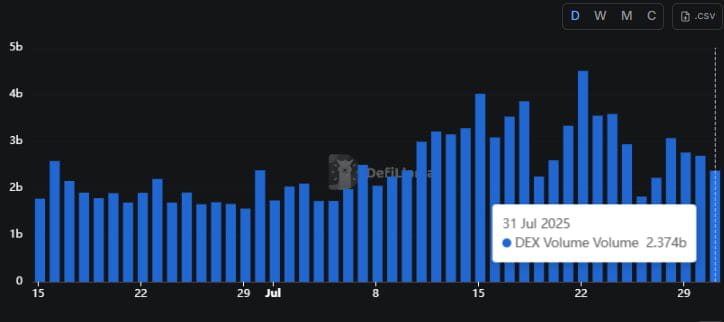Recent comments from co-founder #solana Anatoly Yakovenko have alarmed speculative traders.
Against the backdrop of these statements, the blockchain recorded a decline in activity on decentralized exchanges. In a post on X from July 27, Yakovenko stated that NFTs and meme coins have no intrinsic value. He compared them to loot boxes from mobile games, primarily used by speculators.
After these words, market sentiment deteriorated significantly. Trading volume on DEX $SOL dropped from $3.071 billion on Monday to $2.374 billion today, representing a decrease of about 22%.

Although sharp declines in the crypto industry are not uncommon, some market participants see a connection between Yakovenko's statements and the current decline.
Meme coins helped the growth of Solana.
The irony of the situation immediately caught the attention of the crypto community. Although meme coins have no real utility, they became one of the main reasons for Solana's recent growth.
Almost all popular thematic cryptocurrencies of recent years were launched on this network. $PNUT , $WIF , FARTCOIN, the current PENGU — the list can go on.
In addition, the largest platforms for launching meme coins operate on Solana, including Pump.fun and Raydium. During periods when leading blockchains like Ethereum and Cardano remained calm, Solana thrived due to viral meme coins and #NFT .
Against this backdrop, leading DEX platforms in the network, such as Jupiter, showed sharp growth during meme coin hype seasons.
It is thanks to these projects that Solana was able to build a strong community, form its own culture, and achieve significant growth momentum. Therefore, many perceived Yakovenko's words as a 'blow to the hand that fed the ecosystem.'
Slowing trading on Solana DEX after resonant statements.
Decentralized exchanges based on Solana have faced a noticeable decline in activity just a few days after controversial comments from Yakovenko.
It is unclear whether the 20% decrease in volumes is related to a natural market correction or a reaction to the co-founder's statements, but the Solana ecosystem felt the impact. Judging by the sentiment, some participants may begin to consider other platforms for launching meme coins.
For many digital asset enthusiasts, meme coins and NFTs are not just speculative assets, but part of the crypto culture, accessibility, and creativity of Web3. Moreover, they lower the entry threshold for newcomers, allowing them to quickly become part of the ecosystem.
Meme coins are devoid of value but create excitement.
Yakovenko's words were not unfounded. Most meme coins have no other utility than attracting attention.
Meme coins are often criticized for lacking real value and practical use cases. Most of these projects appear solely for the hype and short-term speculation.
Such tokens can show dizzying growth within hours and then swiftly collapse. One illustrative case is LIBRA. The project's capitalization soared to $224 million but soon collapsed, leaving investors with significant losses. Currently, the token's value barely exceeds $3.9 million.
Most often, the life cycle of meme coins is defined by hype rather than real fundamental indicators.
Meme coins attract people and invigorate the market.
Despite their superficiality, meme coins still work. They attract attention and create excitement around digital currencies, bringing new participants into the market.
Such projects often help retail investors join the crypto sphere without delving into complex protocols and technical nuances.
This phenomenon played to Solana's advantage, ensuring its leadership and community attention during periods when the largest blockchains appeared to be fading.
Essentially, Yakovenko's words reflect the truth, but also demonstrate the fragile balance between logic and market behavior. Besides decentralization, it is the entertaining and light side of the blockchain industry that helps it stay alive and attract new users.

